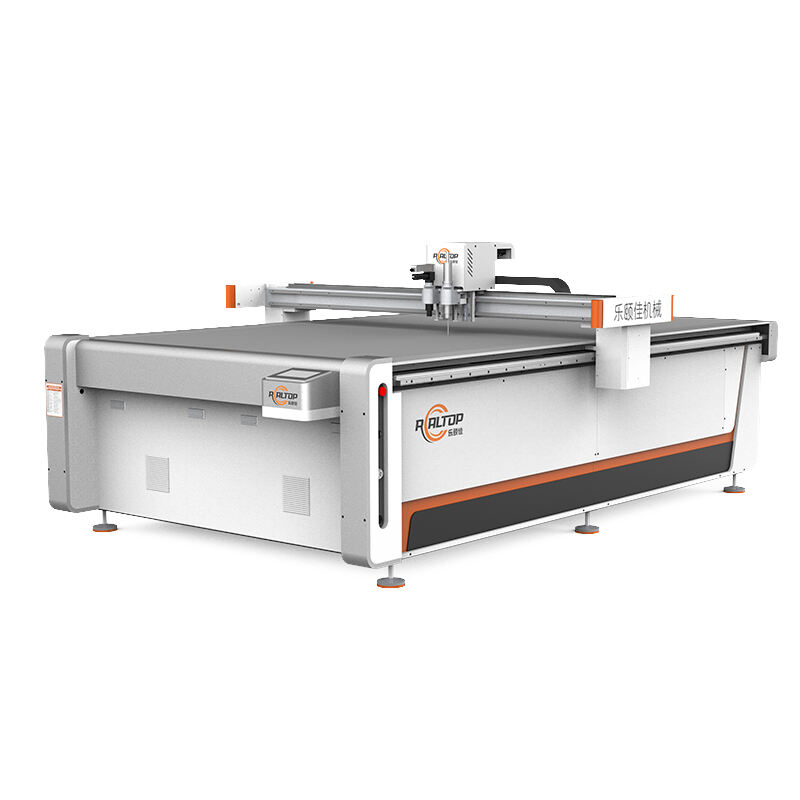¿Qué características mejoran la precisión de las máquinas de corte de impresión?
¿Qué son las máquinas de corte de impresión?
Características clave que mejoran la precisión en las máquinas de corte de impresión
Integración de la tecnología CNC y el diseño digital
- Compatibilidad de archivos digitales : Las máquinas de corte de impresión se conectan a un software de diseño (como Adobe Illustrator o CorelDRAW), lo que permite a los usuarios importar archivos digitales directamente. La máquina lee las medidas del diseño y corta en consecuencia, asegurando que el producto final coincida exactamente con el plan digital.
- Recortes programables : Una vez cargado un diseño, la máquina puede repetir el mismo corte cientos o miles de veces con la misma precisión. Esto es esencial para la producción en masa, donde la consistencia entre cada pieza es clave.
- Microajustes : Los sistemas CNC permiten ajustes mínimos (medidos en milímetros o incluso en micras) del camino de corte, asegurando que incluso las formas complejas, como curvas, ángulos o pequeños detalles, se cortan con precisión.
Sensores y herramientas de alineación de alta resolución
- Sensores ópticos : Muchas máquinas tienen cámaras o sensores ópticos que escanean las marcas de matrículapequeñas marcas impresas en el materialpara alinear el corte con el diseño impreso. Por ejemplo, si una hoja de etiqueta tiene impresos logotipos, el sensor lee las marcas de registro para asegurarse de que la máquina corta a la perfección cada logotipo, incluso si la hoja está ligeramente desalineada.
- Detección de bordes : Los sensores pueden detectar los bordes del material, ajustando la trayectoria de corte para que coincida con el tamaño real del material. Esto es útil para materiales que pueden tener ligeras variaciones en las dimensiones, como papel hecho a mano o tela de forma irregular.
- Sistemas y guías de redes : Las guías físicas, reglas o líneas de cuadrícula en la superficie de trabajo de la máquina ayudan a los usuarios a colocar los materiales correctamente antes de cortar. Algunas máquinas también tienen abrazaderas o camas de vacío para mantener los materiales planos y evitar el desplazamiento durante el corte.

Herramientas de corte de precisión y tecnología de cuchillas
- Profundidad ajustable de la hoja : Diferentes materiales requieren diferentes profundidades de hoja. Por ejemplo, para cortar cartón grueso se necesita una hoja más profunda que para cortar papel delgado. Las máquinas de precisión permiten a los usuarios ajustar la profundidad de la hoja en pequeños incrementos, asegurando que la hoja corte el material limpiamente sin dañar la superficie de trabajo de la máquina.
- Hojas afiladas y de buena calidad : Las hojas opacas causan cortes desiguales, rasgaduras o bordes dentados. Las máquinas de corte de impresión de precisión utilizan hojas afiladas y duraderas, a menudo hechas de acero de alta velocidad o carburo de tungsteno, que permanecen afiladas durante más tiempo. Algunas máquinas también tienen afiladores automáticos de cuchillas o recordatorios para reemplazar las cuchillas cuando se desgastan.
- Herramientas especializadas para diferentes materiales : Además de las cuchillas estándar, las máquinas pueden incluir herramientas como cuchillas de corte de beso (que cortan la capa superior del material sin cortar el soporte), cuchillas rotativas (para cortes suaves en tela o vinilo) o herramientas de pliegue (para pliegues precisos en cartón). El uso de la herramienta adecuada para el material garantiza una precisión óptima.
Motores paso a paso y control de movimiento suave
- Resolución de paso alto : Los motores paso a paso con alta resolución de paso pueden moverse en incrementos extremadamente pequeños (tan pequeños como 0,01 milímetros), lo que permite que la cabeza de corte siga curvas y diseños intrincados con movimientos suaves y precisos. Es por eso que las máquinas CNC pueden cortar formas detalladas como patrones de encaje o logotipos complejos con esquinas afiladas y líneas limpias.
- Control de velocidad constante : La máquina ajusta la velocidad de corte según el diseño. Por ejemplo, puede reducir la velocidad en las curvas agudas para asegurar un giro preciso, y luego acelerar en líneas rectas para aumentar la eficiencia. Una velocidad constante evita que la hoja se arrastre o salte, lo que puede distorsionar el corte.
- Vibración reducida : Los motores y las piezas móviles están diseñados para minimizar las vibraciones, que pueden hacer que la hoja se tambalee y genere cortes desiguales. Los marcos o materiales amortiguadores de gran peso absorben las vibraciones, manteniendo la cabeza de corte estable durante el funcionamiento.
Características de software para personalización y calibración
- Herramientas de calibración : Con el tiempo, las máquinas pueden desarrollar pequeñas imprecisiones debido al desgaste o a los cambios de temperatura. Las máquinas de precisión tienen características de calibración que permiten a los usuarios ajustar la trayectoria de corte para garantizar la precisión. Por ejemplo, si la máquina corta constantemente 1 milímetro a la izquierda del diseño, el software de calibración puede corregir este desplazamiento.
- Preajustes de corte personalizados : Los usuarios pueden guardar ajustes preestablecidos para diferentes materiales o proyectos, almacenando configuraciones como profundidad de la hoja, velocidad y tipo de herramienta. Esto asegura que cada vez que corte pegatinas de vinilo o tarjetas de visita, la máquina use las configuraciones exactas que brindan la mejor precisión, sin necesidad de reconfigurarlas manualmente.
- Previsión y simulación : Muchos programas de software permiten a los usuarios ver la ruta de corte en la pantalla antes de comenzar, lo que les permite verificar si hay errores o superposiciones. Algunos incluso simulan el proceso de corte, destacando posibles problemas como áreas donde la hoja puede atascarse o cortar demasiado profundamente.
Superficies de trabajo duraderas y estables
- Cuadro fuerte : Las máquinas de corte de impresión de precisión tienen marcos rígidos y resistentes a la flexión o al desplazamiento durante el funcionamiento. Esta estabilidad garantiza que la cabeza de corte se mueva exactamente donde debe, sin movimientos no deseados.
- Superficies de trabajo planas y lisas : La superficie de trabajo (donde se colocan los materiales) debe ser perfectamente plana. Cualquier deformación o desigualdad puede hacer que los materiales se sienten de manera desigual, lo que conduce a cortes inconsistentes. Las máquinas de alta calidad utilizan materiales gruesos y rígidos como acero o aluminio para la superficie de trabajo, asegurando que permanezca plana con el tiempo.
- Diseños adjuntos : Algunas máquinas industriales tienen áreas de corte cerradas que protegen contra el polvo, los desechos o las corrientes de aire, que pueden afectar a materiales ligeros como el papel o el vinilo durante el corte.
Preguntas frecuentes
¿Cómo manejan las máquinas de corte de impresión materiales gruesos sin perder precisión?
¿Pueden las máquinas de corte de impresión cortar diseños complejos con pequeños detalles?
¿Con qué frecuencia se calibra la máquina de corte de impresión?
¿Las máquinas de corte de impresión funcionan con todos los materiales?
¿Cuál es la diferencia entre las máquinas de corte de impresión manual y automática en términos de precisión?
Tabla de Contenido
- ¿Qué son las máquinas de corte de impresión?
-
Características clave que mejoran la precisión en las máquinas de corte de impresión
- Integración de la tecnología CNC y el diseño digital
- Sensores y herramientas de alineación de alta resolución
- Herramientas de corte de precisión y tecnología de cuchillas
- Motores paso a paso y control de movimiento suave
- Características de software para personalización y calibración
- Superficies de trabajo duraderas y estables
-
Preguntas frecuentes
- ¿Cómo manejan las máquinas de corte de impresión materiales gruesos sin perder precisión?
- ¿Pueden las máquinas de corte de impresión cortar diseños complejos con pequeños detalles?
- ¿Con qué frecuencia se calibra la máquina de corte de impresión?
- ¿Las máquinas de corte de impresión funcionan con todos los materiales?
- ¿Cuál es la diferencia entre las máquinas de corte de impresión manual y automática en términos de precisión?
 EN
EN
 AR
AR
 FR
FR
 DE
DE
 IT
IT
 KO
KO
 PT
PT
 RU
RU
 ES
ES



